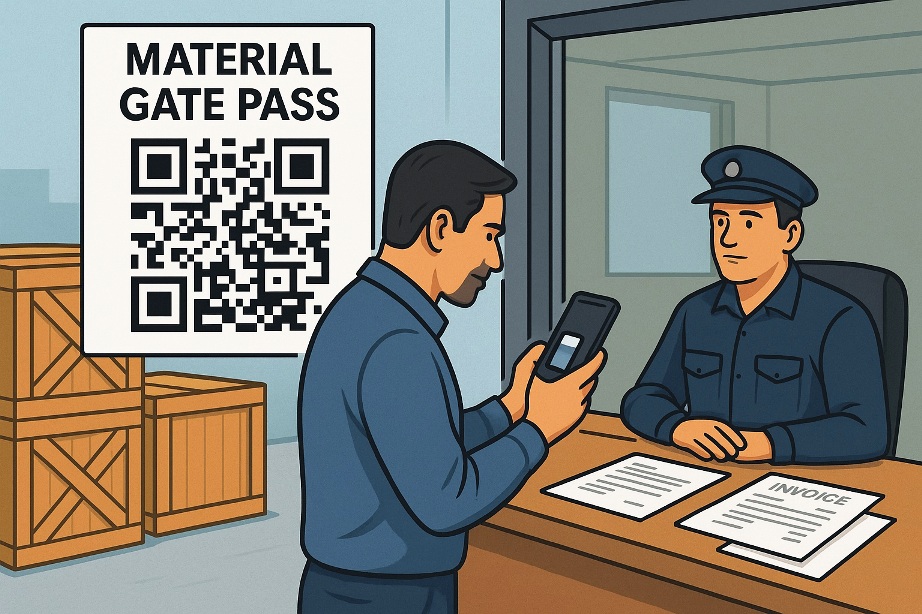Why use Material Gate Pass Software to Manage material Movement
Published on 8/20/2025 • Updated on 8/20/2025

Managing what enters and leaves your premises should not feel like detective work. Yet for many factories and warehouses, material movement still relies on paper registers, Excel files, and scattered invoice trails. The result? Gaps in accountability, delays at the gate, and painful audits.
This article breaks down the hidden costs of manual gate passes, then introduces a modern alternative VisitorFlow’s Material Gate Pass Software with a clear, step-by-step look at how it works and the benefits you can expect.
The Problem: Manual Gate Passes Create Blind Spots
1) Data entry errors & missing details
Handwritten registers and ad-hoc spreadsheets invite mistakes: illegible handwriting, skipped fields, wrong quantities, and inconsistent units. Minor typos snowball into stock mismatches and vendor disputes.
2) Slow approvals and bottlenecks
When stores or security approvals happen via phone calls or paper signatures, trucks wait and operations stall. Approvers are hard to reach, and nothing moves without them.
3) Poor traceability
Finding “who cleared what” on a specific date means flipping pages or chasing emails. Attaching proofs (POs, challans, photos) is manual and scattered, making investigations and audits time-consuming.
4) Compliance risk
Without standardized fields and immutable logs, it’s easy to miss mandatory information. Auditors expect a clear, time-stamped trail; paper rarely provides that.
5) Limited visibility for stakeholders
Operations, purchasing, and finance teams often work with stale or incomplete data. That leads to inventory discrepancies, delayed GRN posting, and inaccurate planning.
6) Vulnerability to fraud or misuse
Manual processes make it hard to detect duplicate passes, reused serial numbers, or unauthorized movements especially across multiple gates or sites.
The Setbacks You Feel Every Day
- Longer truck turnaround times (TAT) due to slow data capture and approvals.
- Reconciliation headaches between gate registers, GRN entries, and invoices.
- Disputed claims with suppliers or customers caused by unclear records.
- Stressful audits with missing or inconsistent documentation.
- High administrative overhead to maintain spreadsheets and paper trails.
Meet VisitorFlow: Digital Material Gate Pass Software
VisitorFlow offers a single, cloud-based system to record, track, and trace every material movement inbound or outbound right at the factory or warehouse gate.
- Deployed at the gate: Replace paper registers with guided digital forms.
- 90% less manual intervention: Standardized fields, automated checks, and one-click approvals reduce human effort dramatically.
- Centralized, secure records: Every entry is time-stamped and stored safely in the cloud with role-based access.
- ERP/GRN integration: Seamless data flow into your existing GRN or ERP via APIs—no retyping, no duplication.
How VisitorFlow Works (Step by Step)
Step 1: Initiation (Inbound or Outbound)
Security or stores staff choose Inbound (materials arriving) or Outbound (materials leaving).
Step 2: Digital Data Capture at the Gate
A structured form ensures clean, complete data:
- Material description, quantity, UOM
- Vendor/customer, PO/DC/Challan references
- Vehicle number, driver details
- Gate, department, requested by
- Optional: attachments (photo of challan, invoice, packing list)
Built-in validations prevent missing fields, wrong formats, or duplicate pass numbers.
Step 3: Smart Approval Workflow
Configurable routes Stores, Security, or both, receive instant notifications. Approvers review details and supporting documents, then Approve / Decline with remarks. No phone-tag, no paper chase.
Step 4: Gate In/Out & Time Stamps
On arrival and dispatch, staff record IN and OUT with automatic time stamps. You get an immutable timeline of each movement.
Step 5: ERP/GRN Sync (via API)
Approved entries sync to your GRN or ERP system automatically. This removes duplicate typing and keeps inventory accurate across systems.
Step 6: Live Dashboard & Audit Trail
A real-time dashboard shows:
- Today’s inbound/outbound passes
- Pending approvals
- Exceptions (e.g., overdue outbound, quantity variance)
- Site, gate, department, or vendor views
Every action who created, who approved, when IN/OUT happened is captured in a tamper-evident audit log.
Step 7: Reports & Exports
Generate period-wise summaries, vendor-wise movement, item-wise quantities, and exception reports. Export for finance, compliance, or management reviews.
What You Gain (Benefits You Can Measure)
- Accuracy by design: Standardized forms + validations = fewer mistakes.
- Speed: Faster approvals and truck TAT reduction at the gate.
- Traceability: End-to-end visibility with attachments and time stamps.
- Compliance readiness: Clean, searchable logs for audits and investigations.
- Operational alignment: Instant data for stores, purchase, security, and finance.
- Seamless ERP flow: API integration eliminates double entry and delays.
- Scalability: Multi-gate, multi-site support with role-based access controls.
- Security: Cloud storage with backups and granular permissions.
Typical Use Cases
- Raw material receipts (inbound) with PO matching
- Finished goods dispatch (outbound) with delivery references
- Tooling/asset movement across plants
- RMA/repair returns with serial tracking
- Contractor material issues/returns
Why Now?
If your team still reconciles paper registers with spreadsheets and ERP at month-end, you’re carrying unnecessary risk and cost. Digitizing the gate is a fast, high-ROI win that strengthens inventory accuracy, compliance, and throughput without changing your ERP.
Get Started
Ready to replace manual registers with a clear, secure, and integrated material movement process?
VisitorFlow Material Gate Pass Software helps you digitize the gate, cut manual work by ~90%, and keep every movement auditable inbound to outbound.
Want a walkthrough tailored to your workflows and ERP? I can map your current process and show exactly how VisitorFlow slots in, step by step.
- What Is Courier Management Software and Why Your Office Needs It
- Cloud-Based QR Code Visitor Management Outperforms Paper Registers and Static Desktop Software
- DPDP-Compliant Visitor Onboarding: What Security & HR Must Capture at the Gate
- Transforming Visitor Gate Passes into Legally Enforceable Visitor Experiences
- Visitor Lanyards vs. Visitor Stickers: Why It’s Time to Make the Switch
- Case Study Video : Incident reporting & management software
- How QR Code-Based Incident Reporting Transforms Manufacturing Operations
- Transforming Visitor Management: Ensuring Legal Compliance and IP Protection with Cloud-Based Software
- Step-by-Step Guide to Visitor Management in Manufacturing Factories
- Lanyard Infections: A Hidden Risk in Workplaces